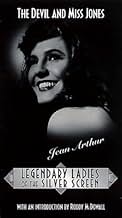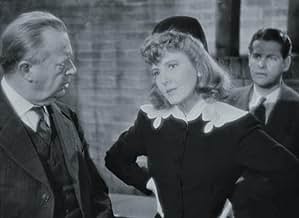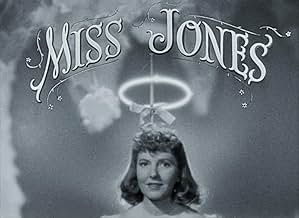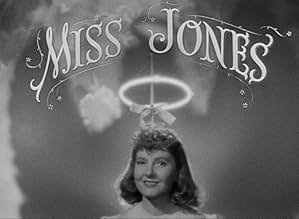NOTE IMDb
7,6/10
5 k
MA NOTE
Ajouter une intrigue dans votre langueA tycoon goes undercover to ferret out agitators at a department store, but gets involved in their lives instead.A tycoon goes undercover to ferret out agitators at a department store, but gets involved in their lives instead.A tycoon goes undercover to ferret out agitators at a department store, but gets involved in their lives instead.
- Nommé pour 2 Oscars
- 3 victoires et 2 nominations au total
S.Z. Sakall
- George
- (as S.Z. Sakall)
Avis à la une
This is a wonderful story from the days immediately preceding America's entry into WWII, when the values that made America great were on display in the movies. A powerful department store owner, played by Charles Coburn, gets a job as a lowly clerk in his own store, in order to ferret out the workers who are trying to organize a labor union. He gradually gets caught up in the lives of the clerks in the shoe department (co-stars Jean Arthur, Bob Cummings, Spring Byington, Edmund Gwen) who accept him as just a poor, older man, and his view of things begins to shift. There are some excellent scenes in this movie, especially one in which Coburn is arrested while on a day at the beach with his fellow workers, and has to be kept out of jail by Cummings' bravado. Of course, everything works out well in the end, because this movie was made in the days when good was destined to triumph over evil.
This film is under the radar for one reason only: character actors Charles Coburn and Spring Byington step from behind the shadow of the leads and take a bite out of the script themselves, and man, what a bite. Not to say that Jean Arthur and Robert Cummings don't do their part, because they do, but the emphasis here is on the old folks for a change, and its a refreshing change. There's also a scene on Coney Island, back when it was the shizzle, and its a wonderful scene for warmly placing you there in the midst of a steaming humanity all trying to cool off. There's a Caprasque story impetus about the problems of the rich versus the poor, along with some liberal solutions to those problems, but what's really nice is about watching folks who are past redemption finding it at the most unexpected time of life. Hope for everyone here. Too bad its only a movie.
I saw this movie for the first time on TCM, during their run-up to the 2005 Oscars. I expected quaint, cute, pleasant. What I got was much more: strong writing and characters, believable performances, a sure hand of the director who knew how to make comedy work on-screen, an interesting story with plot twists. Even after more than six decades, this comedy still works well. Today's comedy directors and writers could learn a lot from this film: how to make the situations and characters work without shoving in the audience's face. Sam Wood gives the audience for this film some credit for intelligence, and lets the strength of the script and actors emerge. For the first time, I realized just what fine actors are Charles Coburn and Jean Arthur.
10jotix100
Norman Krasna, was one of the best screen writers in the movies of the period. Sam Wood shows his ability to direct this excellent cast in one of the most satisfying comedies about the distinctions between the moneyed classes and the working stiffs they employed.
If you haven't seen the film, please stop reading now.
J.P. Merrick, is a millionaire who has investments all over New York. It is to his amazement he sees himself burned in effigy in front of the department store he has forgotten he owns. Merrick, like all people in business don't want to appear to be exploiting the workers, but this is too much! He must put an end to it.
In disguising himself as a salesman, he goes directly where the problem seems to be coming from, the shoe department. There he meets Mary Jones, who immediately feels Tom Higgins, his assumed name, is a man that is going through a rough time in his life. Mary feels pity when she realizes he doesn't know a thing about salesmanship.
In spite of everything going bad for him as a shoe salesman, Tom sticks to his new persona. He only meets kindness from all the people he is trying to fire. Merrick, by the end of the first full day at the store feels the strain of being on his feet all the time; we watch him soaking his feet in hot water, aided by his butler, George. In the process of gaining knowledge about the trouble makers, Merrick becomes human. He gets to realize how wrong he has been about a life he has lived so alienated from.
"The Devil and Miss Jones" is a movie that will delight anyone wishing to have fun. Of course, this is a film that depends totally in the two principals, Jean Arthur, who plays Mary Jones, and Charles Coburn, who as J.P Merrick/Tom Higgins shows why they were about the best actors working in the cinema in the 30s and 40s in Hollywood. Not only did they bring such class to whatever they played, but they are totally convincing. Ms. Arthur was a natural and so was Mr. Coburn.
The rest of the cast is extraordinary. A young Robert Cummings is perfect in his role as the union man. Spring Byinton, an actress that appeared in many films, is a charming Elizabeth, the woman that steals Merrick/Higgins heart. In her first scene with Mr. Coburn, she sits in the park bench to have lunch and he has nothing to eat. She gives him one of her tuna popovers and clarifies for him she paid 12 cents for the can! What times! In minor roles, S. Z. Sakall is George, the loyal butler. Mr. Sakall is a joy to watch, no matter what picture, or what character he is playing. Also, Edmund Gwenn, who probably stayed behind to played Santa Claus for the store, makes an incredible Hooper, the man in charge of the shoe department.
Thanks to Sam Wood's inspired direction this is a film that will not cease to please.
If you haven't seen the film, please stop reading now.
J.P. Merrick, is a millionaire who has investments all over New York. It is to his amazement he sees himself burned in effigy in front of the department store he has forgotten he owns. Merrick, like all people in business don't want to appear to be exploiting the workers, but this is too much! He must put an end to it.
In disguising himself as a salesman, he goes directly where the problem seems to be coming from, the shoe department. There he meets Mary Jones, who immediately feels Tom Higgins, his assumed name, is a man that is going through a rough time in his life. Mary feels pity when she realizes he doesn't know a thing about salesmanship.
In spite of everything going bad for him as a shoe salesman, Tom sticks to his new persona. He only meets kindness from all the people he is trying to fire. Merrick, by the end of the first full day at the store feels the strain of being on his feet all the time; we watch him soaking his feet in hot water, aided by his butler, George. In the process of gaining knowledge about the trouble makers, Merrick becomes human. He gets to realize how wrong he has been about a life he has lived so alienated from.
"The Devil and Miss Jones" is a movie that will delight anyone wishing to have fun. Of course, this is a film that depends totally in the two principals, Jean Arthur, who plays Mary Jones, and Charles Coburn, who as J.P Merrick/Tom Higgins shows why they were about the best actors working in the cinema in the 30s and 40s in Hollywood. Not only did they bring such class to whatever they played, but they are totally convincing. Ms. Arthur was a natural and so was Mr. Coburn.
The rest of the cast is extraordinary. A young Robert Cummings is perfect in his role as the union man. Spring Byinton, an actress that appeared in many films, is a charming Elizabeth, the woman that steals Merrick/Higgins heart. In her first scene with Mr. Coburn, she sits in the park bench to have lunch and he has nothing to eat. She gives him one of her tuna popovers and clarifies for him she paid 12 cents for the can! What times! In minor roles, S. Z. Sakall is George, the loyal butler. Mr. Sakall is a joy to watch, no matter what picture, or what character he is playing. Also, Edmund Gwenn, who probably stayed behind to played Santa Claus for the store, makes an incredible Hooper, the man in charge of the shoe department.
Thanks to Sam Wood's inspired direction this is a film that will not cease to please.
Charles Coburn was a funny man. I wish had more movies with him in them, as he usually makes me laugh. He did here, and this movie was on it's way to a rating of "10" when it bogged down midway through and never really regained momentum. It did have a nice sentimental ending, though.
Coburn, meanwhile, was outstanding as the super-rich owner of a department store who goes "underground" as a shoe salesman in his store to find out the cause of worker unrest. Then romance takes over the story: Coburn and Spring Byington and then Bob Cummings and Jean Arthur and the story loses a lot of it comedy touch and its zip.
Overall, the film still exudes charm and Coburn, despite third billing, IS the star of this film. I'm sure a number of fans of this film are disappointed it still isn't out on DVD.
Coburn, meanwhile, was outstanding as the super-rich owner of a department store who goes "underground" as a shoe salesman in his store to find out the cause of worker unrest. Then romance takes over the story: Coburn and Spring Byington and then Bob Cummings and Jean Arthur and the story loses a lot of it comedy touch and its zip.
Overall, the film still exudes charm and Coburn, despite third billing, IS the star of this film. I'm sure a number of fans of this film are disappointed it still isn't out on DVD.
Le saviez-vous
- AnecdotesJean Arthur planned to remake the picture with her as the devil titled "The Devil and Mr. Jones", but that project never materialized.
- GaffesDuring the beach scene, the people in the background change completely from shot to shot. However, the crowd in the opening shot of the beach scene is the same as the one in the final shot.
- Citations
First Policeman: When they start recitin' the Constitution, watch out!
- Crédits fousThe foreword after the opening credits reads: Dear Richest Men in the World: We made up this character in the story, out of our own heads. It's nobody, really. The whole thing is make-believe. We'd feel awful if anyone was offended. Thank you, The Author, Director and Producer. P.S. Nobody sue. P.P.S. Please.
- ConnexionsFeatured in Ebert Presents: At the Movies: Épisode #1.12 (2011)
- Bandes originalesThe Blue Danube Waltz, Opus 314
(1867) (uncredited)
Written by Johann Strauss
Played aboard ship at the end and danced by Merrick and the employees.
Meilleurs choix
Connectez-vous pour évaluer et suivre la liste de favoris afin de recevoir des recommandations personnalisées
- How long is The Devil and Miss Jones?Alimenté par Alexa
Détails
- Date de sortie
- Pays d’origine
- Langue
- Aussi connu sous le nom de
- The Devil and Miss Jones
- Lieux de tournage
- Société de production
- Voir plus de crédits d'entreprise sur IMDbPro
- Durée
- 1h 32min(92 min)
- Couleur
- Rapport de forme
- 1.37 : 1
Contribuer à cette page
Suggérer une modification ou ajouter du contenu manquant




































